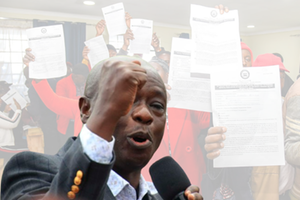36 hours to breaking point: What Dr Obwogi's story teaches us about women in medicine

Dr Desree Moraa, medical intern at Gatundu Level 5 Hospital, Kiambu County. She died by suicide.
What you need to know:
- The news coverage suggests that Dr Obwogi experienced overwork (36-hour shift), harassment at work and burnout.
- She had sought emotional solace in a pet, was not drawing any salary and depended on a friend for accommodation.
On the heels of World Suicide Prevention Day marked on September 10 was a report that a 27-year-old female medical intern, Desree Moraa Obwogi, died by suicide on September 22. Coincidentally, this came in the wake of a report titled “Suicide rates among physicians compared with the general population in studies from 20 countries: Gender stratified systematic review and meta-analysis” by Claudia Zimmermann, Susanne Strohmaier, Harald Herkner, Thomas Niederkrotenthaler and Eva Schernhammer, and published in the August 2024 issue of BMJ.
The report analysed 42 datasets for male physicians and 27 for female counterparts based on studies published between 1960 and March 31, 2024. It established that female physicians faced a 24 per cent higher risk of suicide compared to the general population, a marked improvement from two decades ago when it was at 76 per cent. But it also noted that the suicide rate ratio of male physicians was significantly raised when other professional groups with similar socioeconomic status were used as a reference group.
The news coverage suggests that Dr Obwogi experienced overwork (36-hour shift), harassment at work and burnout. She had sought emotional solace in a pet, was not drawing any salary and depended on a friend for accommodation. Colleagues who commented about the case cited unpleasant work conditions endured by medical interns in the backdrop of threats to their careers by demeaning supervisors, and exposure to traumatising stories of patients, worsened by lack of psychosocial support.
Dr Chibanzi Mwachonda, a medical practitioner in Nairobi, was reported to have related this to "moral injury", described as “psychological trauma that occurs when healthcare workers are unable to provide the care they know is necessary because of constraints beyond their control” and which “can lead to feelings of guilt, shame and helplessness, contributing to mental health issues”. These factors point to an unjust and inhumane working environment for medical interns, betraying insensitivity by the government to their plight.
The conditions that Dr Moraa faced are a replica of factors cited in a September 2021 publication titled “Mental illness and suicide among physicians” by Samuel B. Harvey and colleagues in The Lancet. The article describes “some aspects of physician training, working conditions and organisational support” as “unacceptable”.
It warns that despite its appeal, the medical profession “comes with stressors”. It further observes that “like in the general population, the most common mental disorders reported among physicians are depression and anxiety”, noting that these conditions are most visible among doctors aged 30 years and below.
Read: The pain of being a medic in Kenya: My hopeless battle with debt, low pay and suicidal thoughts
Burnout, “characterised by emotional exhaustion, cynicism and feelings of being ineffective”, is identified as one of the probable causes of suicide among physicians. Other factors are: access to and knowledge of lethal means to use; reluctance to seek support (because of confidentiality concerns and fear of loss of career); and self-stigma.
There are also “excessive or conflicting job demands, an imbalance of work and family life, long working hours, and interpersonal conflict”. For junior physicians during training, the factors include “excessive working hours, study and examinations”.
Interviewed by The Harvard Gazette after publication of their study, Schernhammer (one of the authors of the 2024 study) averred that female physicians “have a much higher completion rate than women in the general population who attempt suicide and tend to use different means if they commit suicide”.
In addition, “unlike men, female physicians are more likely to use poisoning, and they are much more knowledgeable about what exactly they need to do to effectively kill themselves that way”.
Although they did not capture the reasons behind the higher rates of suicide among female physicians, Schernhammer considered that the ones cited in other studies were plausible. Obviously then, they should be new frontiers of research, and not just for women but for men as well.
Establishing the actual causal factors empirically, rather than speculating about them, would significantly contribute to determining the most relevant solutions to apply to reduce suicide rates among physicians from general and gender-specific perspectives.
As pointed out by the two studies cited, these could include workload management, better home-work balance, social support systems, healthier work environments, greater attention to doctors’ mental health, improved health seeking behaviour, peer support, more disclosure and more public discussions about the issue.
Also proposed are: progressive development of self-awareness and effective coping skills; access to good quality services and appropriate treatment; modifications within the health system; and adequate compensation.
The studies on this subject largely focus on developed countries. For example, the two cited studies reviewed data from Europe, the United States of America and Australasia. This suggests the need for data from other regions for a wholesome picture and comparative purposes, and to explain factors behind any variance.
The writer is a lecturer in Gender and Development Studies at South Eastern Kenya University ([email protected]).





